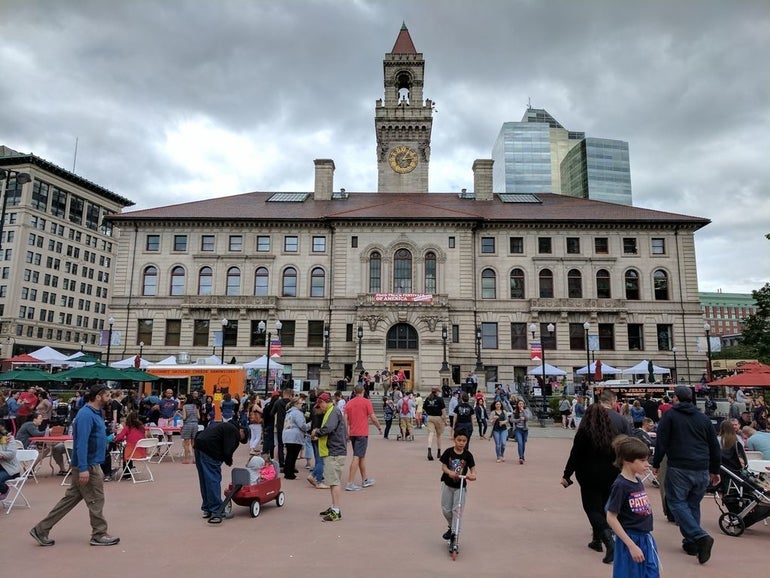Property tax override attempts at 30-year low
 Photo/Grant Welker
Worcester City Hall
Photo/Grant Welker
Worcester City Hall
Property tax override attempts are at a 30-year low, cities and towns have roughly doubled their total savings over the past ten years, and municipalities over the past decade have tripled the amount they could raise under the local tax limit but choose not to, according to new data.
The Massachusetts Taxpayers Association's annual report on the revenues and expenses of the state's 351 cities and towns showed just 20 Proposition 2 1/2 property tax override votes in fiscal 2018, the lowest number since 1990.
According to the foundation, which released its report on Friday, municipalities averaged more than 100 override votes per year between fiscal 2001 and fiscal 2010. Twelve of the 20 overrides taken in fiscal 2018 were approved, raising a total of $8.8 million.
Total municipal revenues and spending rose to $28.4 billion in fiscal 2018, a $1.1 billion or 4.2 percent increase over the prior year and the highest rate of growth since the economic recovery began in fiscal 2010. It's the third time in the last five years that growth has exceeded 4 percent.
While Beacon Hill officials are proudly pointing to a state rainy day reserve fund balance that exceeds $2 billion, cities and towns have been saving too. Total municipal government savings reached $1.18 billion at the start of fiscal 2018, and have risen $560 million since fiscal 2009.
Citing the last year for which data is complete, the foundation reported the number of municipal full-time equivalent employees grew by just over 3,000 in fiscal 2017. The total municipal workforce has decreased by more than 13,000 over the last 15 years, but remains sizable with nearly 260,000 full-time equivalent positions.
The report also looked at a category known as "excess capacity," or the amount of additional taxes a city or town may collect without seeking to override Proposition 2 1/2, which limits local property tax increases. At $611 million, excess capacity has nearly tripled in the last decade. In fiscal 2018, excess capacity grew by $48 million, or 8.5 percent, the first time since fiscal 2010 that growth has not exceeded 10 percent.
However, the report cites a "wide variance" in excess capacity levels, - more than 150 communities have excess capacities of 0.5 percent or less of their total tax levy, while excess capacity in 82 cities and towns is less than .005 percent of the local tax levy.
On the expense side of the equation, the report said that while cost data is not complete, it appears that municipal health insurance costs will show an increase of more than 5 percent in fiscal 2017, the highest growth rate since fiscal 2010. Municipal pension appropriations increased by 6.9 percent in fiscal 2018, the fourth straight year that pension appropriations have increased by at least 6 percent.
The report also again highlights a long-term trend: growing reliance locally on property taxes, easily the largest source of municipal revenues.
Over the 20-year period from fiscal 1999 to fiscal 2018, local aid to cities and towns has shrunk from 28 percent of municipal revenues to 19 percent, "the result of relatively strong property tax growth as well as the local aid cuts that took place in each of the last two fiscal downturns," the report said.
Local aid, mainly Chapter 70 state education aid and so-called unrestricted aid, totaled $5.4 billion in fiscal 2018, an increase of 1.9 percent over the previous fiscal year, according to the report. A third category of municipal revenues, described in the report as "local receipts," boasted the strongest gains in a decade and now nearly rivals local aid, the report shows, accounting for $5.1 billion in local revenues.
The local receipts category includes motor vehicle excise taxes, service fees and local option taxes on hotel and meals. Vehicle excise revenues totaled $799 million in fiscal 2018, an increase of 5 percent over fiscal 2017. Currently, 167 municipalities levy a meals and hotels tax, 87 levy at least one local option tax, and 97 communities do not levy either local option tax, the report said.
The share of local expenses covered by local property taxes has shot up from about 52.5 percent in fiscal 2008 to more than 58 percent of all municipal revenues in fiscal 2018, with the share rising in nine of ten years. The report attributes the trend in part to the state's strong real estate market, noting the assessed value of residential properties in Massachusetts grew by 5.7 percent from fiscal 2017 to fiscal 2018.









0 Comments